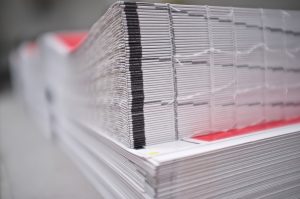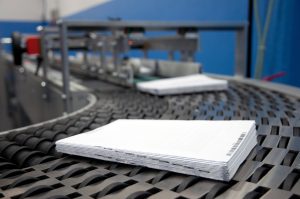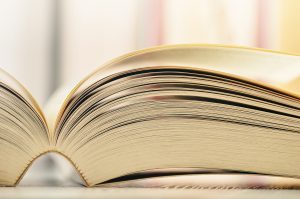

There’s so much more to binding than just paperback or hardcover. From the look to the weight to the longevity of the finished publication, it’s important to know how each binding technique can suit the unique needs of your publication and differentiate you from the competition.
In this series, we explore how different binding processes are performed in a commercial setting and how they affect the final product.
What is Sewn Binding?
Sewn binding is one of the oldest binding methods in history, and it is still the most durable form of binding for printed products today. Sewn binding is a process which utilizes thread sewn through printed signatures to bind them together. There are multiple types of sewn binding, but the most widely used method is Smyth sewing. Sewn binding is most often used for hardcover or casebound publications, but sewn binding methods can be used for softcover products as well. Sewn binding is commonly used for premium novels, illustrated books, children’s books, textbooks, yearbooks, large catalogs and coffee table books.
Assembly required
Industrial manufacture of sewn binding products varies between machinery and binderies, but the main processes of sewn binding are as follows.
As with other offset or digital printing processes, sewn-bound publications begin with folded signatures. A signature is a grouping of pages (usually in increments of four up to 32) that are all printed on the front and back of one large sheet and folded together using a folding machine to paginate the sheets.
In Smyth sewing, which is also called section or saddle sewing, thread is sewn through the middle of each signature out and into the center of the next signature in a looping motion. In another method of sewn binding, called McCain or side stitching, thread is sewn down through the sides of all the signatures at once.

Before the sewn book block is bound with a hard or soft cover, the threads on the spine are compressed to reduce thread buildup and force out excess air. Thread buildup occurs when the thickness of the book block is increased due to the alignment of the thread stitches, and this extra thickness is compressed either through nipping, a process where the spine is clamped and pressure is applied only to the spine, or smashing, where pressure is applied to the entire front and back of the book.
In another process called backing, the book block is clamped between steel plates and the binding edge of the signatures are bent outward over the clamped edges, resulting in a spine that is wider than the rest of the pages. This is sometimes necessary to shape the spine to effectively fit into its cover, and it creates a slight nailhead for the covers to rest on and impresses hinge creases that allow the book to open. The stitched book blocks are then sent to a binder where they are glued and trimmed.
For case binding, the sewn book block receives bracket tape in addition to being glued off, and the book block is trimmed before casing in. For softcover binding, glue is applied to the spine of the book and the cover is attached before it is trimmed to size. In reference to sewn binding methods, gluing off is a process in which glue is applied to the spine of the book block to reinforce the thread sewing and the shape of the spine.
 A three-knife trimmer, most often attached inline on the binder, is used to trim the three unbound edges of the publication, also known as the head, foot and thumb edges. In the process of softcover binding, endsheets are not required and the binding is complete after the book is trimmed and the glue has dried. Through a special method offered for Smyth softcover books, there is a layflat option which does not glue the spine of the book block directly to the spine of the cover. This layflat binding method allows the pages to be more flexible to stay open for use of the product.
A three-knife trimmer, most often attached inline on the binder, is used to trim the three unbound edges of the publication, also known as the head, foot and thumb edges. In the process of softcover binding, endsheets are not required and the binding is complete after the book is trimmed and the glue has dried. Through a special method offered for Smyth softcover books, there is a layflat option which does not glue the spine of the book block directly to the spine of the cover. This layflat binding method allows the pages to be more flexible to stay open for use of the product.
If a casebound option is selected, an adhesive is used to coat the endsheets, which are attached to the outside pages of the book block and the inside of the hard or soft cover. The spine of the book block can be glued either to the spine of the cover or to backing material which wraps around the stitching to span between the spine creases. Although there are many ways to customize the sewn binding process, the end result will always be a durable and long-lasting, high-quality publication.
Use cases for sewn-bound products
Sewn binding is a popular method for premium printed products with exceptional quality. However, this option can increase the cost and take longer to produce. Thread sewing ensures a greater resistance to wear from years of frequent use, and sewn binding including adhesives provides more reinforcement to the spine and page stability than sewn binding alone.

Publications produced through sewn binding are most often used for hardcover or casebound printed products because sewn binding results in a more durable, layflat books. Unlike perfect binding, sewn binding is suitable for publications with heavier papers.
Enhancements can include edge treatments, headbands and bookmarks. Edge treatments include enhancements like edge staining and gilding, where dyes, colorants or gold leaf is applied to the non-spine edges of the book block. Headbands are strips of decorative cotton or silk that are attached to the top and bottom of the spine, and bookmarks are cord or ribbons which are attached to the top of the spine to serve as ornamental placeholders.
Since Smyth sewn binding sews each signature together one at a time, the binding it creates has more flexibility. If that spine is adhered to the liner and not the spine of the cover, the product will have the ability to lay flat. Layflat capabilities are important when there are images or spreads that span the gutter between the pages. This is great for art portfolios and coffee table books where design and longevity are equally important factors.
Weighing the options
When considering sewn binding for printed products, important variables to be considered are page count and layflat capabilities. The Smyth sewing process allows flexibility for the pages due to the layflat nature of the product. Sewn binding creates a durable finished product, and it is the most suitable binding technique if a long-lasting, professional publication is desired. This is particularly beneficial when its readers will appreciate the craftsmanship of the finished piece.
If you are considering sewn binding for your next print project with ¶¶Тс¶МКУЖµ or you would like to speak with someone, our knowledgeable staff can help you find the best option for your publication!
